Cozy Slow Cooked Summer Beef Casserole Recipe for Sunny Days
Summers bring unexpected magic when slow cooked beef casserole becomes your ultimate comfort companion.
Rich aromas fill kitchens with warm promises of deliciousness.
Our recipe combines tender meat and seasonal vegetables in a hearty blend.
Savory ingredients meld together, creating layers of complex flavors that dance across taste buds.
Each spoonful tells a story of patient cooking and culinary creativity.
Simple techniques transform ordinary ingredients into an extraordinary meal that feels like a warm embrace.
Come discover how effortless and satisfying this dish can be for your next gathering.
Slow Cooked Summer Beef Casserole To Savor
Essential Ingredients For Summer Beef Casserole
Main Protein:Vegetables:Liquid and Seasoning Components:Instructions For The Perfect Beef Casserole
Step 1: Prepare Sizzling Beef Base
Heat olive oil in a large skillet over medium-high heat.
Toss beef chunks with flour, salt, and pepper to create a delicious coating.
Sear the beef pieces until they develop a rich, golden-brown crust, allowing the meat to caramelize and lock in amazing flavors.
Step 2: Boost Aromatic Layers
Mince fresh garlic and sprinkle into the pan.
Stir quickly to prevent burning, letting the garlic release its fragrant essence and complement the beef’s robust taste.
Step 3: Create Liquid Depth
Pour in Guinness and beef stock, using a wooden spoon to scrape up any delicious browned bits from the bottom of the pan.
This process builds incredible depth of flavor for the stew.
Step 4: Add Vibrant Vegetable Medley
Chop and add:Stir these colorful vegetables into the liquid, ensuring they’re well distributed throughout the mixture.
Step 5: Slow Cook to Perfection
Transfer the entire mixture to a slow cooker.
Allow the stew to simmer on low heat for 6-8 hours, transforming the beef into meltingly tender morsels that will make your taste buds dance.
Step 6: Final Flavor Boost
Sprinkle grated parmesan cheese into the stew just before serving, stirring to create a creamy, rich finish.
Step 7: Elegant Serving
Plate the stew and garnish with:Serve alongside fluffy couscous for a complete and satisfying meal that captures the essence of summer comfort food.
Pro Tips For Slow Cooked Beef Perfection
Beef Casserole Variations To Try This Season
Serving Up Summer Beef Casserole With Flair
Storage Tips For Slow Cooked Summer Beef Casserole
FAQs
Yes, you can use chuck roast, stewing beef, or short ribs. Choose cuts that are well-marbled and suitable for slow cooking to ensure tender, flavorful results.
While Guinness adds rich depth, you can substitute with red wine, beef broth, or dark ale if needed. The key is maintaining moisture and adding complexity to the dish’s flavor profile.
Replace regular flour with gluten-free flour when coating the beef. Ensure all other ingredients like beef stock are certified gluten-free to avoid cross-contamination.
Print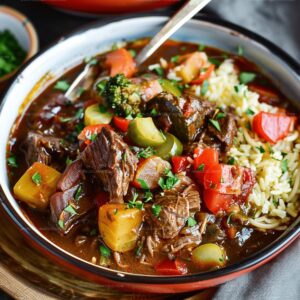
Slow Cooked Summer Beef Casserole Recipe
- Total Time: 8 hours 20 minutes
- Yield: 4 1x
Description
Hearty summer beef casserole celebrates rich, tender meat slow-simmered with garden-fresh vegetables and aromatic herbs. Delicious comfort meets seasonal simplicity, promising a satisfying meal that brings warmth and flavor to your table.
Ingredients
Protein:
- 600 g (1.3 lbs) braising beef, chopped into chunks
Vegetables:
- 1 red bell pepper, chopped
- 1 green bell pepper, chopped
- 1 small courgette/zucchini, chopped into chunks
- 2 cloves garlic, peeled and minced
- 1/4 red onion, peeled and thinly sliced
Liquids and Seasonings:
- 2 tablespoons olive oil
- 2 tablespoons plain (all-purpose) flour
- 1/2 teaspoon salt
- 1/2 teaspoon pepper
- 330 ml (11 oz) Guinness or other ale
- 360 ml (1 1/2 cups) beef stock
- 3 tablespoons grated parmesan cheese
Garnish:
- Freshly chopped parsley
Serving Suggestion:
- Cooked couscous
Instructions
- Prepare a large skillet with olive oil at medium-high temperature, creating a sizzling cooking surface.
- Dust beef chunks with seasoned flour mixture, ensuring complete coverage for optimal browning.
- Sear meat pieces until golden and caramelized, developing rich flavor foundations.
- Introduce minced garlic and quickly toast for 45-60 seconds, releasing aromatic compounds.
- Deglaze pan with Guinness and beef stock, scraping accumulated browned bits from bottom of skillet.
- Incorporate colorful bell peppers and courgette, mixing thoroughly into liquid base.
- Carefully transfer entire mixture into slow cooker, maintaining all developed flavors.
- Set slow cooker to low setting, allowing ingredients to meld and tenderize over 6-8 hours.
- During final 15 minutes of cooking, gently fold in grated parmesan cheese for creamy texture.
- Plate dish with elegant garnish of fresh parsley and thinly sliced red onion atop cooked couscous.
Notes
- Boost the flavor by marinating beef overnight in Guinness for deeper, richer taste notes.
- Swap couscous with cauliflower rice for a low-carb, keto-friendly version of this hearty dish.
- Use gluten-free flour and ensure stock is gluten-free to make this recipe suitable for those with gluten sensitivities.
- For a brighter, fresher profile, add a splash of lemon juice or zest just before serving to lift the deep, slow-cooked flavors.
- Prep Time: 20 minutes
- Cook Time: 8 hours
- Category: Lunch, Dinner
- Method: Slow Cooking
- Cuisine: British
Nutrition
- Serving Size: 4
- Calories: 378 kcal
- Sugar: 2 g
- Sodium: 1440 mg
- Fat: 22 g
- Saturated Fat: 7 g
- Unsaturated Fat: 14 g
- Trans Fat: 0.3 g
- Carbohydrates: 12 g
- Fiber: 3 g
- Protein: 35 g
- Cholesterol: 90 mg

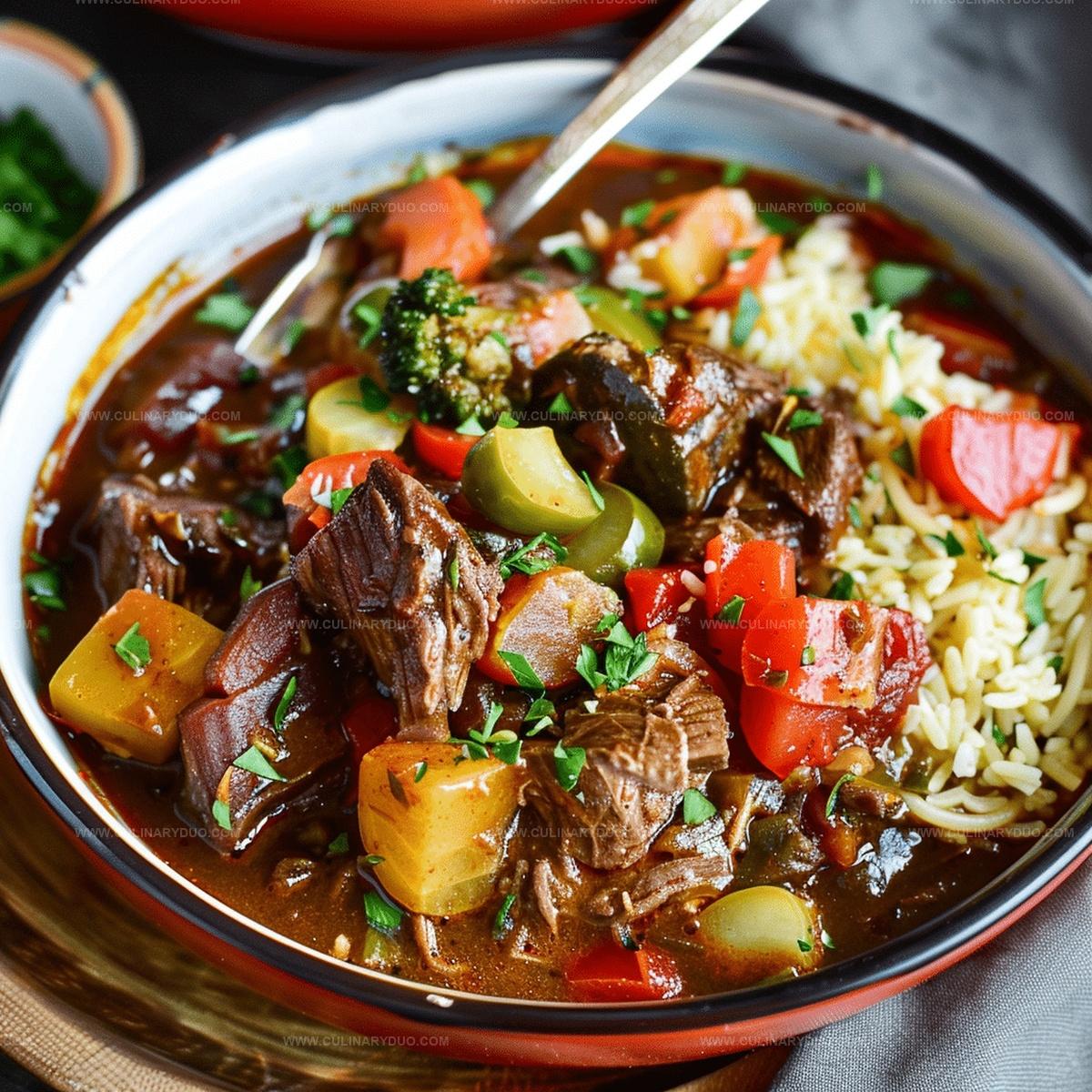
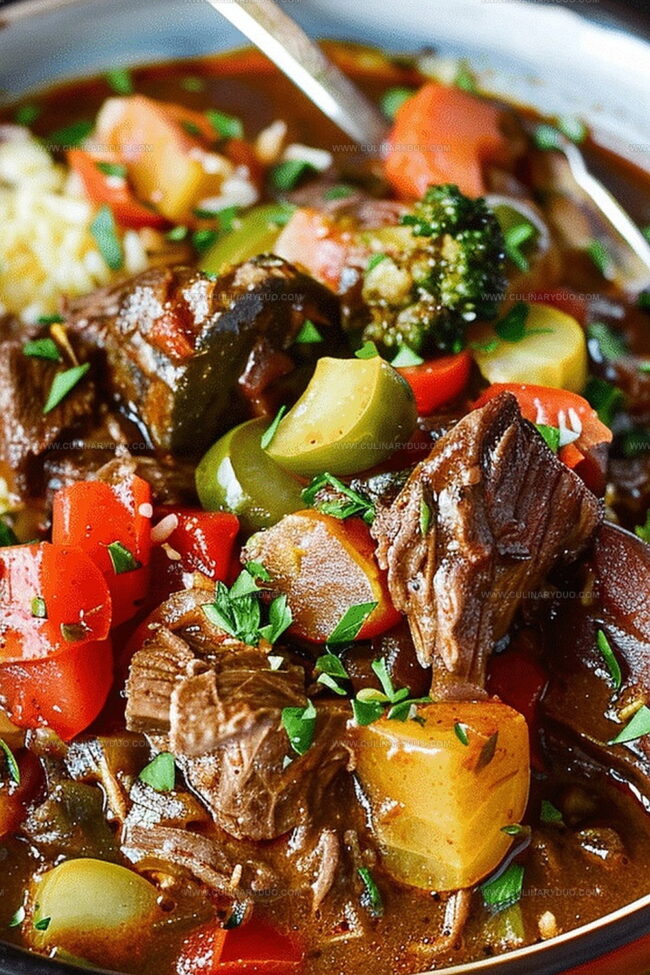
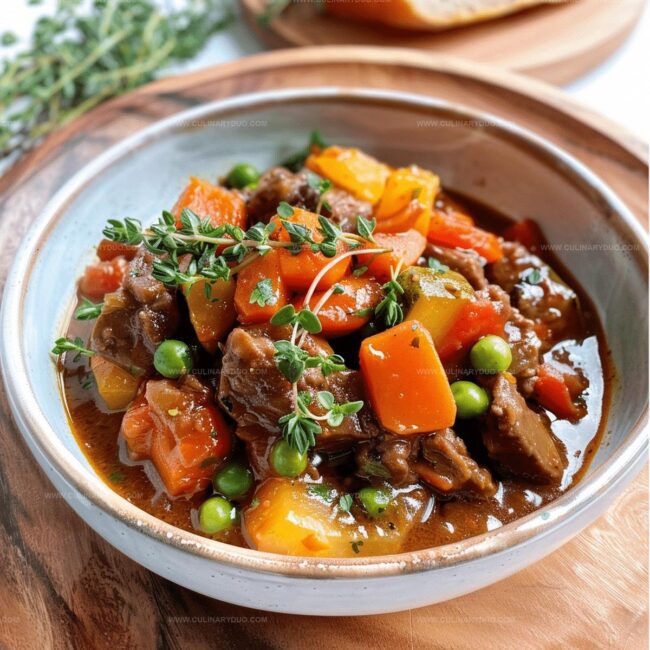
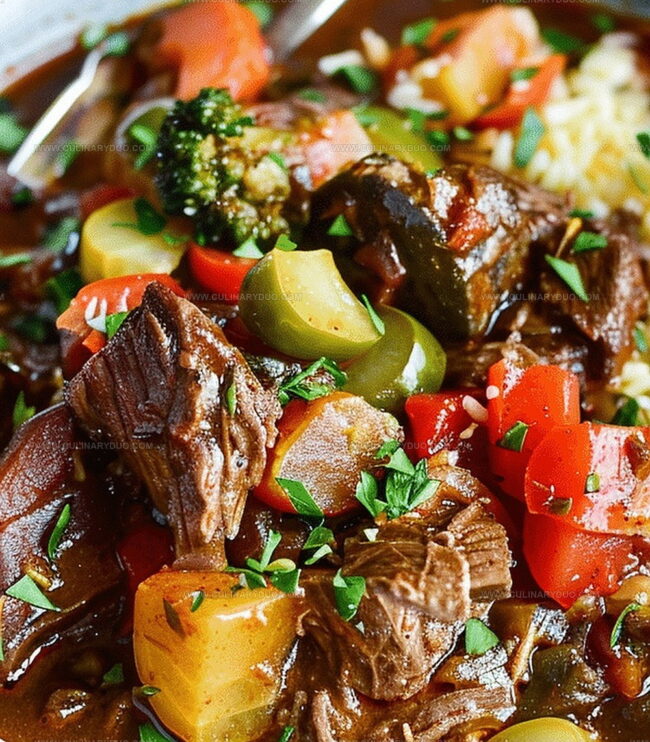
Natalie Brooks
Co-Founder & Content Strategist
Expertise
Education
eCornell
Natalie brings the vibrant, plant-powered side to Culinary Duo. After earning her Plant-Based Nutrition Certificate from eCornell, she combined her love for fresh ingredients with a passion for storytelling, aiming to make healthy cooking simple and satisfying.
Her kitchen motto: good food doesn’t need a fancy label, it just needs fresh ideas and a little creativity. Outside of writing and recipe testing, Natalie’s happiest in her garden, exploring farmers’ markets, or mixing global flavors into new kitchen experiments.